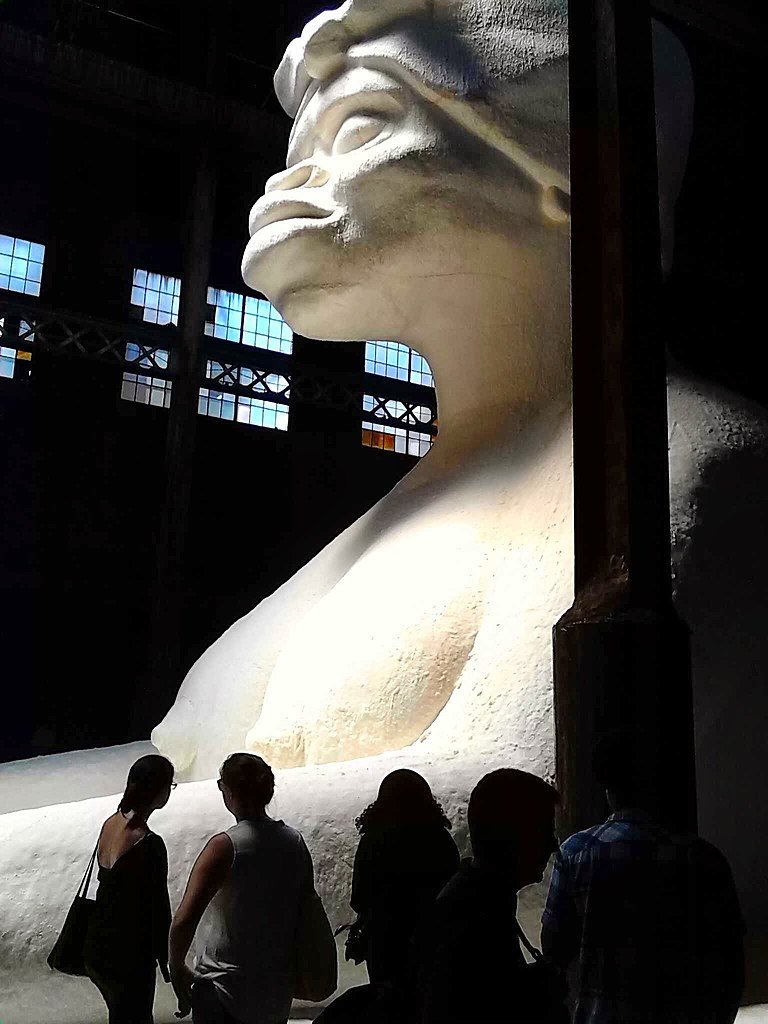Black History Month: Kara Walker
If this artist were a product at the supermarket, she would come with a warning label. Seriously, though, if you are triggered by depictions of sexual violence or negative stereotypes, maybe you should skip this post.
Let’s talk about:
Kara Walker is best known for her silhouette installations about anti-Black racism, colonialism, and sexual violence. She also paints and sculpts. In each medium, though, Walker has used stereotypical images of Black people to attack these issues.
Kara Walker, “A Subtlety, or The Marvelous Sugar Baby.” Photo credit: Adjoajo/Wikimedia Commons
Not surprisingly, she’s pissed off a lot of people, including the legendary sculptor Betye Saar, who essentially said Walker’s work demeans the struggles of Black women merely to entertain white people.
I’m not entirely comfortable with Walker’s work, either. Still, I’m drawn to it because of:
The sheer audacity she’s shown throughout her career
The patience and skill necessary to cut the silhouettes, even with support from assistants
The satirical, grandiose titles of her works, which remind me of 19th century carnival barker exaggerations
Walker is a Problematic Fave. I think she intellectualizes the negative stereotypes as fictions with no basis in reality, but I doubt all her collectors do. If I had to choose between, say, having lunch with Walker or lunch with Betye Saar, I’m not sure who I’d pick.
Still with me? Stick around for tomorrow’s inspiring artist.
Wa Na Wari: a Seattle version of 'Hotel California'
When I reluctantly ended my first visit to Wa Na Wari, I told one of the co-founders if I didn’t get out now, I’d never leave this home-turned-gallery space. Apparently that was plan all along: get people in the door with the art, then lull them into staying. Kinda like Hotel California, but homey instead of sinister.
Wa Na Wari co-founder Rachel Kessler and visitors
Creative reminders of home are woven throughout the house, like the hanging sculptures by Henry Jackson-Spieker. They literally mark “places that were points of gatherings or comfort” when the Greene family lived there.
Henry Jackson-Spieker glass & wood sculpture above family table
Wa Na Wari continues the revived trend of home-based art exhibit spaces. Not pop-ups — permanent galleries. No surprise that New York artists have done this in apartments — or just in one apartment room — considering New York rents. The phenomenon seems to be solidifying in Seattle and nearby communities too, as real estate gets pricier by the minute.
Still from “Remembering Her Homecoming,” a film by Natassja E. Swift
The thing I love the most about Wa Na Wari, though, is it still feels welcoming like a home — not merely a house-shaped gallery. In fact, the view into the backyard shook me for a moment: it’s strongly reminiscent of my grandparents’ home in Kentucky, which no longer exists.
Contemplating art & community with Wa Na Wari co-founder Inye Wokoma
This weekend is an especially good time to visit: environmental artist and icon Marita Dingus is teaching a doll-making class on August 11th. Plus, her own doll sculptures are on display upstairs.
Selected works by Marita Dingus
If you have so much fun you can’t bear to leave, don’t say I didn’t warn you.
Three things you don't do at the Seattle Art Fair
Let’s pretend you’re more interested in the air conditioning than the art at the Seattle Art Fair. Here’s a quick etiquette lesson on three things you just… don’t… do… before you get in the door.
1. Don’t talk smack about the art. They can hear you.
Holly Ballard Martz, “Danger of Nostalgia in Wallpaper Form (in utero),” at ZINC Contemporary
Overheard at preview night, about Holly Ballard Martz’s stunning work: “It’s really abortion-y.”
Wow. That was all you got out of this installation of wire hangers, each bent by hand into the shape of a uterus? If you don’t get it, why not ask about the art? That’s what the gallery staff — and the artist — are there for, to talk to you. P.S. Holly’s less ‘abortion-y’ pieces are on the other side of the wall.
2. Don’t touch — not with your hands, butt or shoulder.
Bigert & Bergström, “Incubator for Earthquakes” (provided by the artists)
This is not a children’s museum where you get to play with the exhibits. Don’t touch the art. Even if you intend to buy it. No leaning on the booth walls, either. If you need to sit, use one of the padded benches outside the booth. (While I’m at it: Don’t touch the art in art museums, either. Slow down and breathe deeply until the urge passes.)
3. Don’t hold back on the shine.
Wanna show your followers how amaaaaazing the art is? Go for it — and remember to tag the artist AND the gallery presenting the work. You don’t even have to type in names: take a photo of the wall text identifying the piece and post that too. This one simple action shows you know something about the art world, and you’re not just some rando who’s there for the air conditioning. Bonus: you remember the artwork better when you write something about it. Extra credit bonus: other people get to check out the artist and gallery if they like the work.
One last thing: there will be selfie-bait. Before you take the picture, check your surroundings so you don’t back into the rest of the art. You don’t want to be that person, do you?












